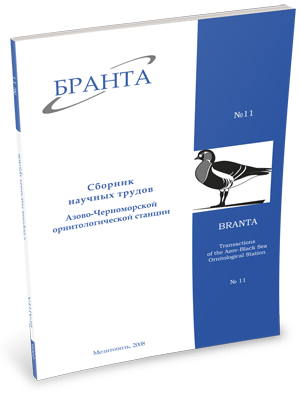
Transactions
of the Azov-Black Sea Ornithological Station



Current and prognosticated estimation of numbers and distribution of the Cormorant (Phalacrocorax carbo sinensis) at water bodies of the Azov-Black Sea coast of Ukraine
V.D. Siokhin, V.A. Kostyushin
Over the last years (1976-2008) breeding settlements of the Cormorant at the Azov-Black Sea coast of Ukraine and within adjacent areas are connected with 17 natural territorial complexes. Five of these areas are in frame of the natural-reserve fund (Danube and Black Sea Biosphere Reserves, Crimean Natural Reserve, Regional Landscape Parks "Kinburn Spit" and "Meotida"). Nine areas have status of wetlands of the international importance (Dniester Delta, Dnieper Delta, Dzharylgachskiy Bay, Central and Eastern Sivash, Molochnyi Liman, Obitochnaya Spit and Obitochny Bay, Berdyanskaya Spit and Berdyanskiy Bay, upper waters of Kakhovskoe reservoir). Two more territories include areas of Kerch Peninsula and the western coast of the Sea of Azov.
During the surveyed period 10 colonial settlements in the study region with Cormorant numbers from 21 to 800 breeding pairs have stopped their existence. Four breeding settlements are the areas with periodic nesting; these are colonies of long-term existence with Cormorant numbers 1900 - 3000 pairs. The main nesting settlements are 24 colonial groups, related to 16 territorial complexes with Cormorant numbers from 80 to 14181 pairs. General limiting factors in the breeding places are disturbance by people and overland predators, influence of the wave erosion on the island complexes.
Following types of the Cormorant nesting are observed: island, arboreal, terrestrial-continental and nesting, connected with technical constructions. The birds with island type of nesting significantly decline in numbers, but numbers of birds breeding on trees increase. In 1985 there were 85.6 % (6982 pairs) of the total bird numbers in the region nesting on islands, but already in 2008 this number was 46.9 % (28555 pairs). At the same time arboreal settlements in 1985 made up 14.4 % (1160 pairs), but in 2008 they numbers 46.9 % (28101 pairs).
The first breeding colonies are known since 1983-1984, they were formed owing to breeding birds from Don Delta and Kuban Region of the Russian Federation. Intensive settling of different areas in the region was observed in 1989-1992 due to developed breeding "centers" at the Azov-Black Sea coast of Ukraine (islands in Karkinitskiy Bay, island complexes in the Eastern Sivash and Obitochny Bay in the Sea of Azov).
Number dynamics of the breeding Cormorants in the region is divided into few periods, but on the whole it may be estimated as "catastrophic" increase in numbers. At the first period (primary forming of the colonies, 1976, 1983-1984) numbers of birds were 245-9146 breeding pairs. At the second period (settling of birds in new areas in the region, 1989-1992) breeding settlements had numbers of 12737-21027 pairs. At the third period (redistribution and development of the occupied breeding areas, 1993-2001) some stabilization in numbers was observed (17392-23766 pairs). For the forth period (redistribution of birds within the breeding habitats, 2002-2008) significant increase in numbers of the Cormorants breeding on the trees and decrease in numbers of the birds breeding in island habitats is typical. Total numbers of the breeding Cormorants over this period are much more than over the previous ones and make up 31751-59946 breeding pairs. Importance of some territorial complexes in maintenance of the Cormorant numbers significantly changes in different years. Most stable and numerous are complexes within the habitats of the Eastern Sivash, where the years with maximal numbers are: 1994 (11454 pairs), 2006 (11831 pairs) and 2007 (12630 pairs). During the other years average number was 5000-7000 pairs. It is connected with significant numbers and areas of the breeding habitats and relatively temperate influence of factors of trouble and disturbance. Since 2004 high numbers are also observed within the habitat complexes of Obitochnaya Spit (3800-11330 pairs), Kerch Peninsula (2000-15911 pairs) and the islands of Kakhovskoe reservoir (1200-6000 pairs).
Proportion of numbers of the breeding population at the Azov-Black Sea coast of Ukraine in a total number of the geographical population of the species (Delany & Scott, 2002) in 2007 was 71.8-88.1 %, and in 2008 - 76.8-94.3 %. Total number of the Cormorants in the region forms nearly 100% (in 2007 - 146140 individuals, in 2008 - 177890 individuals).
Read the paper in a PDF file